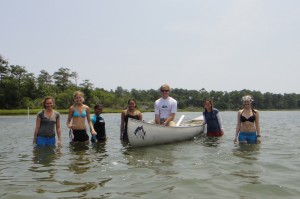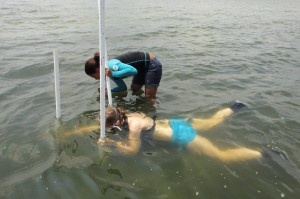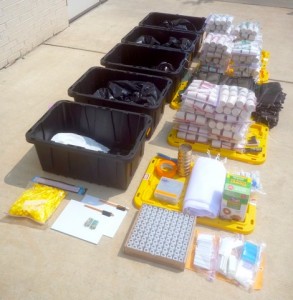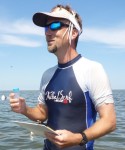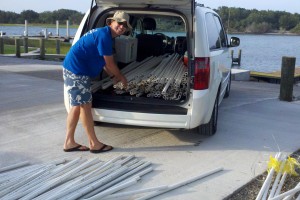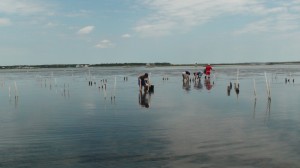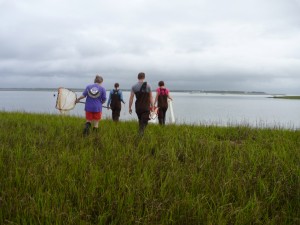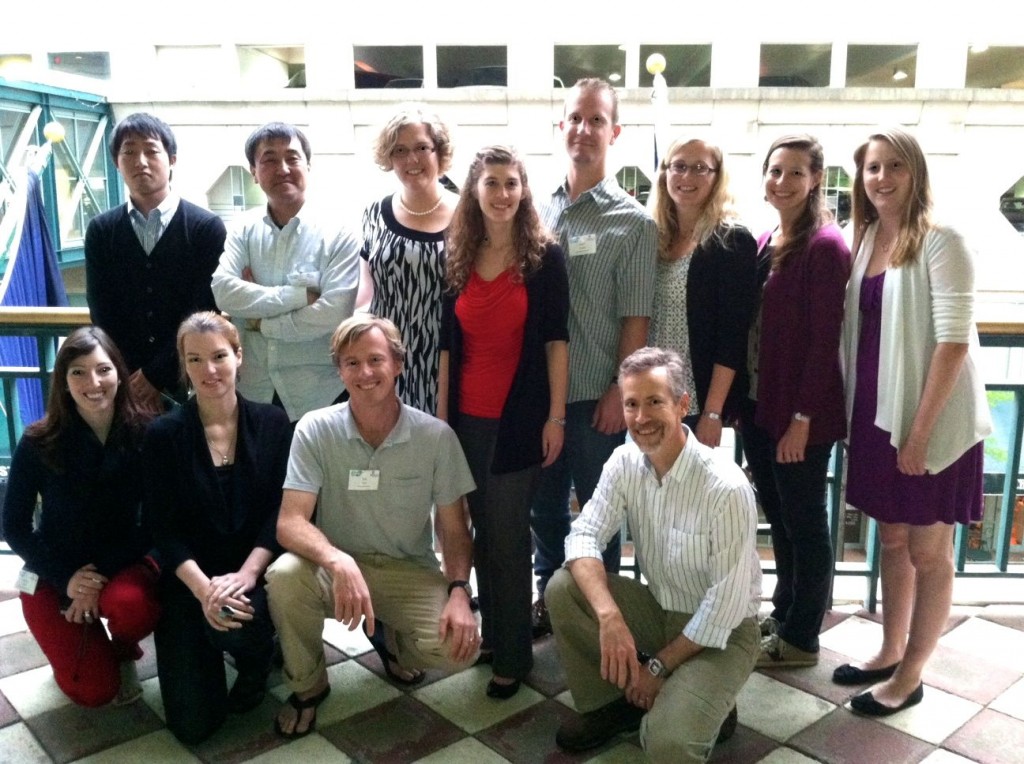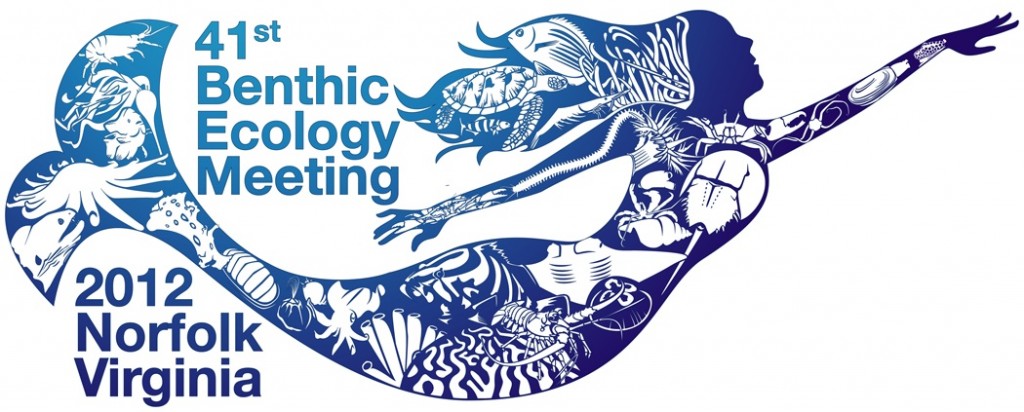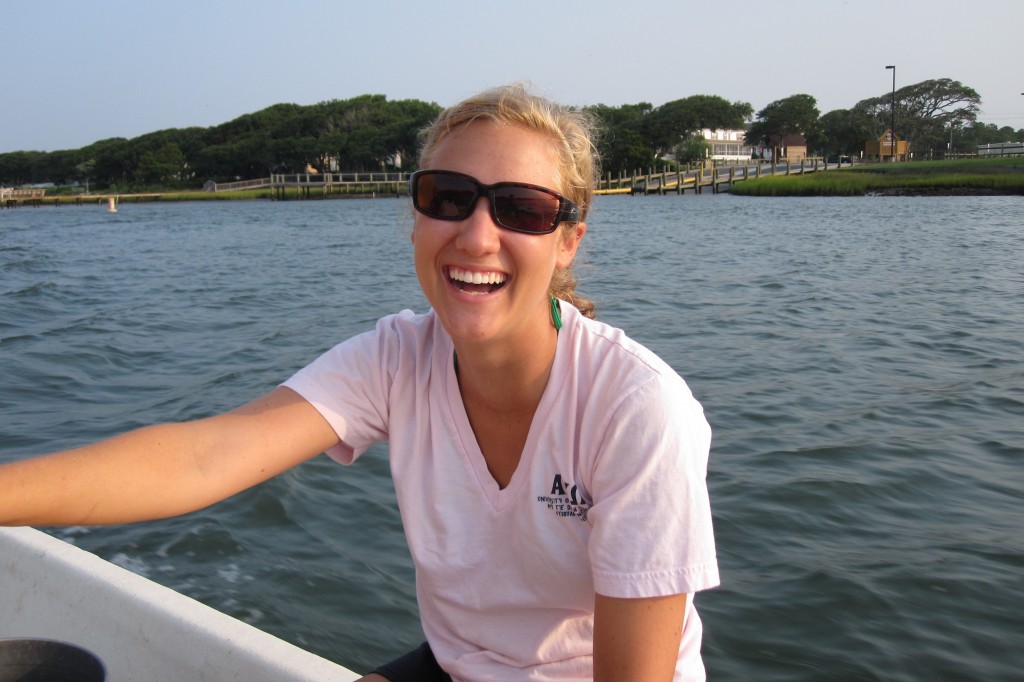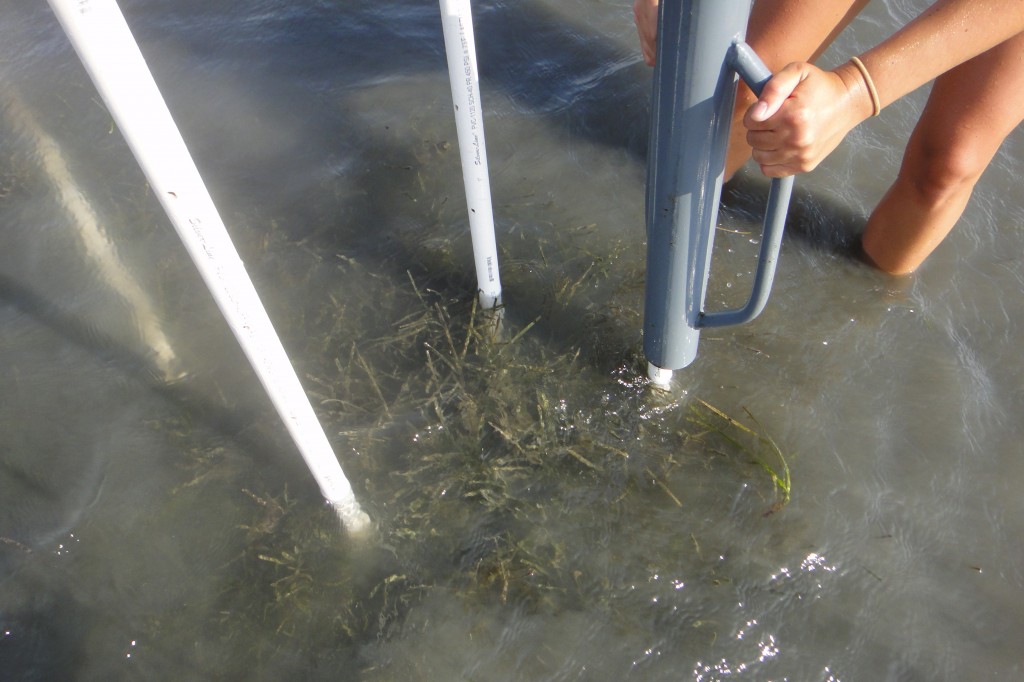A swim down memory lane
by Pamela Reynolds (ZEN coordinator)
The past several months we’ve been entrenched in finishing processing the experimental samples, analyzing data and writing up the results. This is a big switch from our constantly on the go routine during field season, and gives us time to reflect on what an amazing past two years we’ve had with ZEN. In that vein, I’ve dug up two pre-blog posts, quick little snippets I wrote back in the summer of 2011 before we launched the ZENscience.org website.
August 2011: Fieldwork Happens
Out in the field, the one thing I dread most isn’t encountering sharks in the murky water, seeing lightning streak overhead, or being pursued by voracious horseflies. Nope – it’s Murphy’s Law. We’ve all experienced it. A perfectly planned experimental setup can go from a well rehearsed orchestra to utter cacophony in a split second simply because someone forgot to bring scissors or dropped the ruler overboard, or a rogue wave made off with a pencil.
In our case, after placing and pounding 320 poles in the water we realized that our once lovely Zostera bed is now overgrown with Ruppia, a different type of seagrass. In our defense, the seagrass in the clearer water near the approach to the site was, in fact, Zostera. Murphy rears his ugly head, once again. How to deal with the mishap? Remove the poles, all 320 of them, call a few colleagues to find a new site, borrow a boat, and start over. This time everyone knew the drill and the setup went exceedingly smoothly. And, in the process we all learned how to distinguish the three local types of seagrass (Zostera, Ruppia, Halodule) by touch alone in the murky water. Turning Murphy into an educational experience – now that’s science! Having a team of graduate and undergraduate students who keep smiling? Priceless.
[Update: While I still despise coming up short on cable ties in the field, getting caught out on the water during a thunderstorm has quickly risen to fear #1. See the "Science is electric" blog post from 2012 to find out why.]
April 2011: When it absolutely, positively has to be there overnight
In preparing for ZEN the VIMS team became well versed in navigating international shipping. One of the things we learned early on was that customs agents are often quite literal. For instance, “300 blocks of 120 mL hardened dental plaster” can be translated into medical equipment and is subject to high tariffs. Doesn’t matter that the plaster has already been hardened and can’t be used to make casts of someone’s teeth – it’s all in the product description. And being vague isn’t much help either. Some countries want to know the composite materials of a t-shirt or line items of every ingredient in the dog food we used as fish bait, while for others the phrase “for education/research, not for resale” is sufficient. We are expecting that to some extent each country will have unique mesograzer assemblages and ecological interactions – why should we assume their import/export process to be the same?
[Update: I wrote this after a week of playing phone tag and emailing with shipping and customs agents to get our packages cleared and on their way to our international partners. Ultimately everything went through and there were no major delays or disruption of our partners' field schedules. Lesson learned? Leave at least a 3 week shipping allowance for international projects. And, keep UPS on speed dial!]
Road trip to North Carolina
by Paul Richardson (VIMS technician)
photos by Pamela Reynolds (ZEN coordinator)
The road trip begins!
On Friday, June 1, 2012 undergraduate student Katelyn Jenkins and I loaded up a fancy Ford F-150 rental truck with filters, jars, vacuum pumps, and neoprene and set out for The University of North Carolina’s at Chapel Hill’s Institute of Marine Sciences (UNC-IMS) in Morehead City, North Carolina to help Erik Sotka’s (College of Charleston) group break down this summer’s main ZEN experiment. It was a marathon of work, but the good company, nice scenery, rocking tunes, and Oreo cookie snacks made the time fly. We amassed a large group for the effort. Erik’s graduate students, Nicole Kollars and Courtney Gerstenmeier, and his REU intern, Aaron joined Katelyn and me along with UNC-IMS local, Alyssa Popowich to comprise a formidable experimental breakdown team.
Katelyn and I arrived a bit earlier on Friday than the South Carolina contingent, so we helped Alyssa prepare tin envelopes that are used for drying samples in the lab. This prep work was a key task and streamlined the next two days. After helping Alyssa, we grabbed a quick dinner in town and then met up with Erik’s crew. As with any major experimental endeavor, a trip to the store was necessary for last minute supplies which this time included hundreds of Ziploc bags for collecting and storing field samples.
Rocking out in the field and the lab
This was our first major ZEN experiment event in North Carolina without the presence of Pamela Reynolds, the ZEN coordinator, which made us all a bit nervous, but her and Erik’s extensive planning paid off and this was an extremely efficient and productive experimental breakdown. I really enjoyed working with Erik and his crew. Everyone was so positive and they all had an unyielding work ethic. I also learned something interesting about Erik when I asked about the band that he played in back when he was in graduate school. Pamela tipped me off to this fact but she was vague on the details. When I asked Erik, he said it was his only “brush with fame” when he played with the band Cake before they were big. Wow, what a huge ‘brush’! I love Cake. As you may know, Cake is a talented rock band from Sacramento, California with a keystone trumpeter, Vince DiFiori. As Erik said, “Cake would not be Cake without the trumpet,” and I agree! But, during Cake’s embryonic stage they experimented with other wind instruments which included Erik on the saxophone. In another universe, Erik is a music rock star. In this universe, he has to settle with being a marine ecology rock star. Tough break.
Luckily Aaron brought his iPod loaded with thousands of great songs, which kept things lively in the lab as we processed samples. I know it sounds like I’m getting off track here, but good music is essential for tedious long stretches of labwork!
Never a boring moment
One thing that we didn’t do was go sightseeing. Before we left Pamela told me that I should check out some of the various parks andbeaches, (including Fort Macon) if I had the time. While we didn’t have any extra time for sightseeing (I’ll save that for a family vacation) I did see plenty of pretty sights during the course of our field work. Carrot Island on the right and the town of Beaufort on our left made for nice scenery as we motored out to the field site in a local Carolina skiff. A short boat ride towards the inlet brought us to the field site in the Rachel Carson Reserve, which is adjacent to a gorgeous system of Spartina marsh islands called Middle Marsh.
Comparing Virginia and North Carolina
At first glance, the marine environment of Bogue Sound appears similar to the Chesapeake Bay but a critical eye will notice some striking differences. The most conspicuous difference that I noticed was the abundance of intertidal oyster reefs. We had to traverse one to get to our seagrass bed. We used to have numerous oyster reefs in the Chesapeake, but overfishing and disease have had their toll and they have yet to recover. Another interesting comparison was the abundance of sea urchins and brittle stars at Middle Marsh. These animals are rarely, if at all, found in the York River and western side of the Chesapeake Bay, but were all over the place at Middle Marsh. I even saw an urchin hanging out in the middle of one of our experimental plots!
Tiny drifters make fieldwork challenging
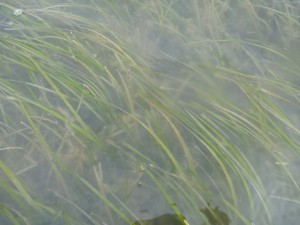
Eelgrass at the ZEN field site in Middle Marsh, North Carolina is home to many marine invertebrates, some benign and others best left undisturbed
Another less exciting difference between the VA and NC ZEN sites was the abundance of hydroids (small jellies). As soon as I waded into the knee deep water and began admiring the lush bed of the eelgrass Zostera marina, a stinging sensation spread along my legs. By the end of the day we were all envious of Nicole, who was smart enough to wear knee high neoprene boots. Although it wasn’t as sharp as a bee sting or even your standard sea nettle, the thoroughness of stung surface area did give the mild sensation that the flesh was melting off of my legs. This was especially true when I showered with fresh water that first night and any remaining unengaged nematocysts (the specialized cells jellies sting you with) exploded into my skin. I’m just glad the water was only knee deep! Alyssa and Pamela warned me about this, but it was too hot to wear a wetsuit and I didn’t have an appropriate dive skin. But, I wasn’t the only one, so there was plenty of camaraderie. The stinging took a few days to go away – a not so pleasant reminder of an otherwise enjoyable experimental breakdown!
Wrapping up
Sunday was another marathon, but this time in the lab. We processed seagrass shoots and scraped off the epibionts (animals and plants living on them), and sorted and preserved the associated mesograzers along with other field samples. We split into two teams to divide and conquer! Except for a short lunch break, we went full tilt until, suddenly, it was 7pm. With the fieldwork completed, lab samples processed, and the local lab somewhat straightened up, we packed up our gear and hit the road. What we planned to take us four days we completed in two. We made it back to Virginia a little before midnight and I slept like a rock. The sun, salt and intense fun of fieldwork will always be my preferred sleeping pill!
ZEN at the 2012 Benthic Ecology Meeting
The Zostera Experimental Network (ZEN) team formally emerged into public view for the first time at the Benthic Ecology Meeting this past week in Norfolk, Virginia. ZEN coordinator Dr. Pamela Reynolds (top center in the photo, in red) presented a first look at the results of our 2011 experiment evaluating the relative importance of grazing, nutrient loading, and abiotic forcing on dynamics of eelgrass (Zostera marina) communities across the Northern Hemisphere.
ZEN had representation from several of our 15 global sites, and a diverse group of PIs, grad students and undergrads, at BEM this year. These included teams from northern Japan (PI Massa Nakaoka and grad student Kyosuke Momota), Quebec (graduate students Julie Lemieux and Laetitia Joseph), Massachusetts (PI James Douglass), North Carolina (PI Erik Sotka, grad students Rachel Gittman and Nicole Kollars, technicians Danielle Abbey and Alyssa Popowich), and Virginia (Emmett Duffy, Pamela Reynolds, Paul Richardson).
The abstract of Pamela’s presentation:
A comparative-experimental approach reveals complex forcing among bottom-up and top-down processes in seagrass communities across the Northern Hemisphere
Pamela L. Reynolds (1); Emmett Duffy (1); Christoffer Boström (2); James Coyer (3); Mathieu Cusson (4); James Douglass (5); Johan Eklöf (6); Aschwin Engelen (7); Klemens Eriksson (3); Stein Fredriksen (8); Lars Gamfeldt (6); Masakazu Hori (9); Kevin Hovel (10); Katrin Iken (11); Per-Olav Moksnes (6); Masahiro Nakaoka (12); Mary O’Connor (13); Jeanine Olsen (3); Paul Richardson (1); Jennifer Ruesink (14); Erik Sotka (15); Jay Stachowicz (16); Jonas Thormar (8)
(1) Virginia Institute of Marine Science, (2) Åbo Akademi University, (3) University of Gronigen, (4) Université du Québec à Chicoutimi, (5) Northeastern University, (6) University of Gothenburg, (7) Universidade do Algarve, (8) University of Oslo, (9) Fisheries Research Agency, Japan, (10) San Diego State University, (11) University of Alaska Fairbanks, (12) Hokkaido University, (13) University of British Columbia, (14) University of Washington, (15) College of Charleston, (16) University of California Davis
Two fundamental challenges to prediction in ecology are complexity and idiosyncrasy. How do we evaluate the importance and generality of multiple, interacting factors in mediating ecological structure and processes? One promising way forward is the comparative-experimental approach, integrating standardized experiments with observational data. In summer 2011 the Zostera Experimental Network (ZEN), a collaboration among ecologists across 15 Northern Hemisphere sites, initiated parallel field experiments exploring bottom-up and top-down control in eelgrass (Zostera marina) communities. Eelgrass is among the most widespread marine plants, forming ecologically and economically important but threatened coastal habitats. We factorially added nutrients and excluded small crustaceans (mesograzers) using a degradable chemical deterrent for four weeks, and measured responses of associated plant and animal communities. As expected, results varied strongly across the global range. Our cage-free deterrent strongly reduced crustacean grazers; at several sites grazer exclusion released blooms of epiphytic algae and/or sessile invertebrates. In Chesapeake Bay, these blooms reduced eelgrass biomass after eight weeks, demonstrating mutualistic dependence between eelgrass and mesograzers. Surprisingly, nutrient addition had little effect on epiphytes, except in Massachusetts and Sweden where grazers are suppressed by mesopredators. Ongoing research is analyzing the relative influence of grazer diversity and environmental forcing in mediating these processes.
Analysis of the 2011 experiments is still under way–even as we swing into high gear for planning the 2012 experiment. We will be presenting the complete results of the 2011 experiment at the Ecological Society of America meeting in Portland (August 2012) and the 47th European Marine Biology Symposium in Arendal, Norway (September 2012). We hope to see you at one or another of these events!
A ZEN-like beginning in North Carolina
By Megan Gyoerkoe, UNC Chapel Hill undergraduate student
One morning, bright and very early, the North Carolina ZEN team packed up the truck and with all the necessary materials for the initial set up of all 40 experimental plots for our experiment. We arrived at our field site behind the Pine Knoll Shores Aquarium and the weather was absolutely beautiful, sunny and warm but with a cool breeze. The tide was calm and the Zostera seagrass beds were vast and lush. After briefly meeting with the aquarium staff our group got started right away, driving the 120+ poles needed to mark the experimental plots into the sediment. About half way through Pamela began to check some of the plots to make sure they had enough Zostera (we were aiming for a minimum of 80% cover). As it turns out what we thought were lush beds of Zostera were actually composed mainly of a different type of seagrass – Ruppia! You can understand that this is a problem given that we are working on the Zostera Experimental Network (ZEN) and not, well REN!
We had spent all morning driving poles into the sediment only to discover that we had been deceived by the seagrass. In disbelief that we could have made such a mistake, we checked and double-checked the plots. Then we went on an extensive Zostera hunt, searching endlessly for a hint of a healthy Zostera bed, swimming through the seagrass even under the threat of being hit in the face by jumping mullets! Turns out it was all in vain and it was back to the drawing board for the ZEN-NC site. What had been an extensive Zostera bed two years before had been replaced almost entirely by Ruppia and some Halodule seagrasses. We spent hours pounding in the poles only to pull them back up the next day.
Fortunately, Pamela, Erik and Rachel were able to work out the logistics for us to work at a new site nearby in Middle Marsh that was actually filled with beautiful, lush Zostera. Even though we had to re-set all of the poles, it turned out to be a wonderful, protected site that was a pleasure to work in.
Field research is definitely a category on its own; it is pleasantly unpredictable, entertaining, exciting and occasionally slightly torturous. Continue Reading

